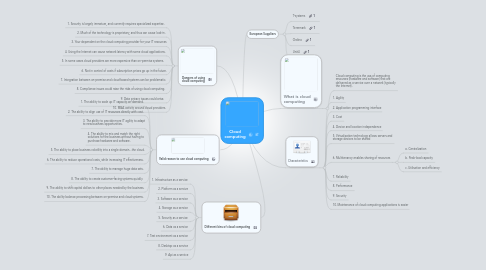Cloud computing
af Laurent De Vriese


1. Valid reason to use cloud computing
1.1. 1. The ability to scale up IT capacity on-demand.
1.2. 2. The ability to align use of IT resources directly with cost.
1.3. 3. The ability to provide more IT agility to adapt to new business opportunities.
1.4. 4. The ability to mix and match the right solutions for the business without having to purchase hardware and software.
1.5. 5. The ability to place business volatility into a single domain...the cloud.
1.6. 6. The ability to reduce operational costs, while increasing IT effectiveness.
1.7. 7. The ability to manage huge data sets.
1.8. 8. The ability to create customer-facing systems quickly.
1.9. 9. The ability to shift capital dollars to other places needed by the business.
1.10. 10. The ability balance processing between on-premise and cloud systems.
2. Different kins of cloud computing
2.1. 1. Infrastructure as a service
2.2. 2. Platform as a sercive
2.3. 3. Software as a service
2.4. 4. Storage as a service
2.5. 5. Security as a service
2.6. 6. Data as a service
2.7. 7. Test environment as a service
2.8. 8. Desktop as a service
2.9. 9. Api as a service
3. Dangers of using cloud computing
3.1. 1. Security is largely immature, and currently requires specialized expertise.
3.2. 2. Much of the technology is proprietary, and thus can cause lock-in.
3.3. 3. Your dependent on the cloud computing provider for your IT resources
3.4. 4. Using the Internet can cause network latency with some cloud applications.
3.5. 5. In some cases cloud providers are more expensive than on-premise systems.
3.6. 6. Not in control of costs if subscription prices go up in the future.
3.7. 7. Integration between on-premise and cloud-based systems can be problematic.
3.8. 8. Compliance issues could raise the risks of using cloud computing.
3.9. 9. Data privacy issues could arise.
3.10. 10. M&A activity around cloud providers.
4. What is cloud computing
4.1. Cloud computing is the use of computing resources (hardware and software) that are delivered as a service over a network (typically the Internet).
5. Characteristics
5.1. 1. Agility
5.2. 2. Application programming interface
5.3. 3. Cost
5.4. 4. Device and location independence
5.5. 5. Virtualization technology allows servers and storage devices to be shared
5.6. 6. Multitenancy enables sharing of resources
5.6.1. a. Centralization
5.6.2. b. Peak-load capacity
5.6.3. c. Utilisation and efficiency
